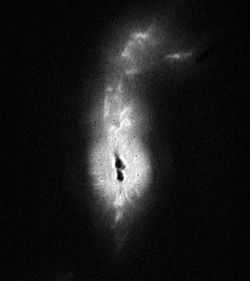R Aquarii
 R Aquarii | |
| Observation data Epoch J2000 Equinox J2000 | |
|---|---|
| Constellation | Aquarius |
| Right ascension | 23h 43m 49.4616s |
| Declination | −15° 17′ 04.202″ |
| Apparent magnitude (V) | 5.72 - 12.4 [1] |
| Characteristics | |
| Spectral type | M7IIIpev |
| U−B color index | 0.32 |
| B−V color index | 1.58 |
| Variable type | Mira Cet |
| Astrometry | |
| Radial velocity (Rv) | -22 km/s |
| Proper motion (μ) | RA: 32.98 mas/yr Dec.: -32.61 mas/yr |
| Parallax (π) | 5.07 ± 3.15 mas |
| Distance | approx. 600 ly (approx. 200 pc) |
| Absolute magnitude (MV) | -6.87 - 0.33 [1] |
| Details | |
| Mass | 1.5, 0.5[2] M☉ |
| Radius | 430, 0.014 [2] R☉ |
| Luminosity | 50,000 - 1.6 [2] L☉ |
| Other designations | |
| Database references | |
| SIMBAD | data |
| Data sources: | |
| Hipparcos Catalogue, CCDM (2002), Bright Star Catalogue (5th rev. ed.) | |
R Aquarii (R Aqr) is a variable star in the constellation Aquarius.
R Aquarii is a symbiotic star believed to contain a white dwarf and a Mira-type variable in a binary system. The orbital period is approximately 44 years.[3] The main Mira-type star is a red giant, and varies in brightness by a factor of several hundred and with a period of slightly more than a year; this variability was discovered by Karl Ludwig Harding in 1810. It has a distance of about 200 parsec, and is one of the nearest symbiotic stars and a well known jet source.[4]
By its gravitational pull, the white dwarf draws in material from the red giant and occasionally ejects some of the surplus in weird loops to form the nebula seen in the linked image.[5] The whole system appears reddened because it is situated in a very dusty region of space, and its blue light is absorbed before reaching us.
The nebula around R Aquarii is also known as Cederblad 211. According to Tom Polakis,[6] as of 1998 no one had succeeded to observe this challenging object visually. It is possible that the nebula is the remnant of a nova-like outburst, which may have been observed by Japanese astronomers, in the year 930 AD.
References
- ↑ 1.0 1.1 http://www.sai.msu.su/gcvs/gcvs/index.htm
- ↑ 2.0 2.1 2.2 M. Gromadzki & J. Mikołajewska (March 2009). "The spectroscopic orbit and the geometry of R Aquarii". Astronomy & Astrophysics 495 (3): 931–936. arXiv:0804.4139. Bibcode:2009A&A...495..931G. doi:10.1051/0004-6361:200810052.
- ↑ <Gromadzki & Mikolajewska (2009). "The spectroscopic orbit and the geometry of R Aquarii". Astronomy & Astrophysics 495 (3): 931¿936. arXiv:0804.4139. Bibcode:2009A&A...495..931G. doi:10.1051/0004-6361:200810052.
- ↑ Stute, Matthias; Sahai, Raghvendra. "Hydrodynamical Simulations of the Jet in the Symbiotic Star MWC 560". The Astrophysical Journal. The American Astronomical Society. Retrieved 10 October 2011.
- ↑ "Aladin previewer". CDS.
- ↑ Polakis, Tom (Oct 1998). "Celestial Portraits: Aquarius". Astronomy 26 (10): 83.
External links
- Weird loop image in R Aquarii
- R Aquarii (HST)
- AAVSO Variable Star of the Month. R Aquarii: Summer 2003
| ||||||||||||||||||||||||||||||||||||||||||||||||||||||||||||||